Fermenting Beer with Wyeast 2002-PC Gambrinus Style Lager Yeast
Published: October 21, 2025 at 9:38:47 PM UTC
Fermenting lager with Wyeast 2002-PC Gambrinus Style Lager Yeast offers homebrewers a clear path to classic continental lagers. This guide is designed for U.S. homebrewers and small craft brewers. It covers lab specs, starter preparation, pitching rates, and fermentation schedules. It also includes recipe building, troubleshooting, lagering, and clarity tips, along with advice on re-pitching and a practical batch log.
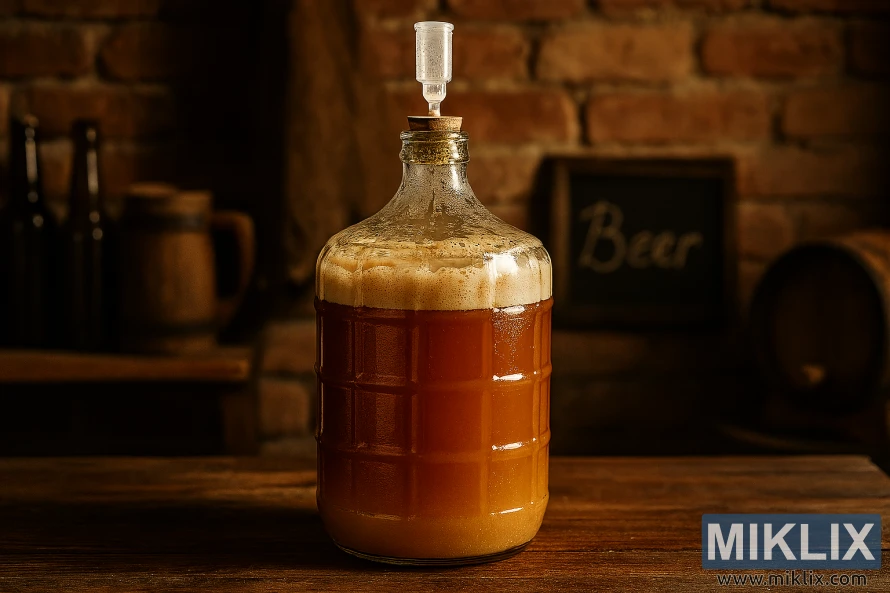
Wyeast 2002-PC is a liquid lager strain known for its clean fermentation and medium-high flocculation. This review will explore how the strain performs in typical 5–10 gallon batches. It will also provide tips for adjusting techniques for consistent results. The guide combines lab data with practical workflow for successful lager fermentation projects.
Key Takeaways
- Wyeast 2002-PC Gambrinus Style Lager Yeast suits clean, continental lager profiles.
- This lager fermentation guide covers starters, pitch rates, and temperature schedules.
- Expect medium-high flocculation and a neutral ester profile in most beers.
- Follow lab specs and a proper starter to maintain yeast health and consistency.
- Practical troubleshooting and a sample batch log help translate theory into results.
Why Wyeast 2002-PC Gambrinus Style Lager Yeast is Popular with Homebrewers
Brewers highly value the Wyeast 2002 strain for its consistent fermentation at low temperatures. Many have reported a smooth, rapid fermentation when kept near 47°F and then warmed to about 60°F. This results in a clean, malty beer with soft floral notes. One brewer even called it possibly the best they’d tasted straight from the fermenter.
The Gambrinus strain's popularity among homebrewers is rooted in practical metrics. It has a typical attenuation of 73%, medium-high flocculation, and can tolerate up to 9% ABV. These characteristics make it ideal for both traditional continental lagers and modern interpretations of the style.
Its ease of use has cemented its status as a homebrew favorite lager yeast. It handles normal lager fermentation ranges well and produces a restrained ester profile. This allows malt and hop character to take center stage. Such reliability is a boon for both new and experienced lager brewers, speeding up the path to consistent results.
The liquid lager yeast benefits are clear in real-world recipes and published examples. Gambrinus is featured in community recipes like the “Old World Pils” on recipe sites and in professional brews. This widespread adoption solidifies its position in both home and professional brewing circles.
- Consistent cold fermentation performance
- Clean malt-forward flavor with subtle floral esters
- Good attenuation and medium-high flocculation
- High alcohol tolerance for stronger lagers
The reasons behind Gambrinus's growing popularity among homebrewers are clear. Its balance of character and practicality keeps it at the forefront of reliable lager options. This makes it a go-to choice for those seeking a dependable strain.
Yeast Characteristics and Laboratory Specs for Gambrinus Style Lager
Wyeast 2002 is a liquid lager yeast with an average attenuation of 73%. It's known for delivering a clean finish, retaining enough malt character for a smooth body. This makes it a reliable choice for brewers aiming for a balanced taste.
The yeast's flocculation is medium-high, ensuring a clear beer without excessive sediment. This characteristic aids in natural settling during cold conditioning, reducing the need for filtration in homebrewing.
The recommended fermentation temperature is between 8–13 °C (46–56 °F). Many recipes target around 52 °F for primary fermentation. This temperature range helps control esters and ensures optimal attenuation.
Wyeast 2002 can handle up to 9.0% ABV, making it suitable for stronger lagers and specialty brews. Its alcohol tolerance supports stable fermentation in worts with moderate gravity.
Lab notes highlight its clean, crisp fermentation with subtle esters and a malty backbone. This profile is ideal for continental lagers and modern American lagers, where a neutral yeast character is desired.
- Form: liquid yeast
- Average attenuation: 73%
- Flocculation: medium-high
- Optimum fermentation temperature: 8–13 °C (46–56 °F)
- Alcohol tolerance: ~9.0% ABV
Pitching guidance suggests lager pitches around 0.35 million cells/mL/°P. This results in substantial cell counts for larger batches. Many homebrewers create a starter to achieve the recommended cell counts.
It's perfect for classic continental styles and American lagers that require a clean, malty flavor. The laboratory specs and performance notes guide brewers in selecting the right yeast for their recipes.
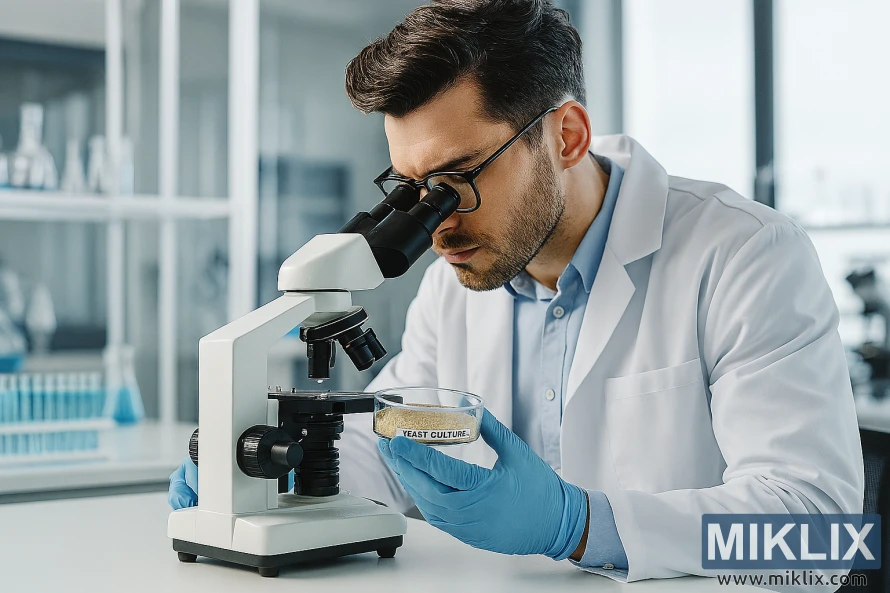
How to Prepare a Starter for Wyeast 2002-PC Gambrinus Style Lager Yeast
Consider if a starter is essential for your brew. Many low-gravity pilsner recipes and fresh large liquid packs might not need extra growth. For higher gravity beers, older slants, or harvested cultures, a Wyeast 2002 starter prep is crucial. It helps reach target cell counts and reduces lag.
Choose a malt wort between 1.040 and 1.050 specific gravity for cell mass building. Ensure the wort is well-aerated and in clean, aerobic conditions for healthy growth. For a typical homebrew batch, a 1–2 L lager yeast starter is usually enough.
Propagate lager strains slightly warmer than fermentation temperatures. Hold the starter at 65–72 °F for rapid growth. Once the starter has grown adequately, chill and acclimate the slurry to fermentation range of 46–56 °F before pitching.
- Use a calculator for target pitching rates; an example reference is 0.35 million cells/ml/°P for lagers.
- For higher gravities or older packs, increase starter size.
- Consider a stepped approach for reused or low-viability yeast to rebuild cell numbers safely.
When making a yeast starter for Gambrinus, decant the spent wort before pitching to avoid off-flavors. Pitch chilled slurry into cold wort for lagers to limit thermal shock. If you prefer, make a liquid yeast starter lager in stages to ensure vigor.
Practical tips help avoid common pitfalls. Sanitize all starter equipment and monitor gravity and activity. If timing is tight, overbuild slightly rather than underpitch, then refrigerate and settle the yeast before decanting.
Follow these steps and you will improve fermentation reliability with Wyeast 2002. Proper Wyeast 2002 starter prep makes a noticeable difference in attenuation and clarity for Gambrinus-style lagers.
Recommended Fermentation Schedule and Temperature Control
Begin primary fermentation at the cooler end of the yeast's range. For Wyeast 2002-PC Gambrinus Style, aim for 47–52 °F (8–11 °C). This helps keep esters and sulfur low. It promotes a clean, malt-forward profile as the yeast consumes sugars steadily.
Primary fermentation can last from several days to two weeks. Factors like pitch rate and oxygenation influence this duration. Monitoring gravity readings is more reliable than time for a precise fermentation timeline Gambrinus.
When gravity nears 1.012, initiate a diacetyl rest by warming the beer. Raise it to roughly 60–64 °F (15–18 °C) for 24–72 hours. This allows yeast to reabsorb diacetyl and complete attenuation. Homebrewers often follow a schedule of 47 °F primary, then warming to ~60 °F near terminal gravity.
Post-diacytel rest and final gravity achievement, cool the beer rapidly. Lagering at near-freezing temperatures encourages flocculation and clarity. Allow several weeks to months for conditioning, depending on batch size and desired clarity.
- Primary: 47–52 °F until activity slows.
- Diacetyl rest: raise to 60–64 °F when near 1.012.
- Cold crash and lager: drop to near 32–40 °F for conditioning.
Effective Wyeast 2002 temp control requires steady setpoints and gentle adjustments. Avoid sudden temperature changes that stress the yeast. Keeping records of gravity and temperature helps refine your personal fermentation timeline Gambrinus for consistent results.
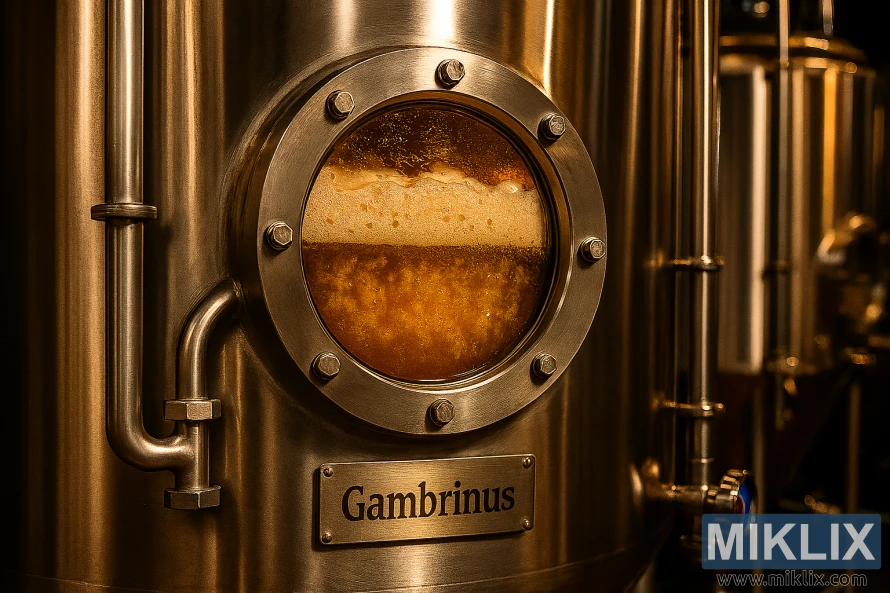
Flavor Profile and Sensory Expectations from This Strain
Anticipate a clean lager yeast character that enhances malt without overpowering it. The Gambrinus flavor profile is characterized by a malty, crisp base. It also boasts a light, soft mouthfeel. Brewers often note that the beer feels balanced and of high quality right from the fermenter.
Wyeast 2002 tasting notes frequently highlight subtle esters lager impressions. These esters manifest as gentle floral or noble-like hints, adding depth. The esters rarely introduce fruitiness, making the beer suitable for pilsners, classic European lagers, and restrained American styles.
Attenuation near 73% results in a moderate body with excellent drinkability. Proper management of fermentation and diacetyl rest minimizes diacetyl incidence. A homebrew report achieved 1.040 to 1.007 without diacetyl, demonstrating the strain's ability to clear and finish cleanly.
Flavor complexity arises from the soft interplay of malt sweetness and subtle floral notes. This strain is ideal when you desire malt presence without yeast dominance. Its clean lager yeast profile supports hop clarity in pilsner and noble-hop driven beers.
In sensory evaluation, look for a crisp finish, mild estery top notes, and a rounded malt backbone. The Gambrinus flavor profile and Wyeast 2002 tasting notes both emphasize restrained character. This complements balanced recipes. The strain benefits from careful temperature control and a proper lagering schedule.
Recipe Building: Grain, Hops, and Water for Use with Gambrinus Style Lager
Begin with a straightforward grain bill for Wyeast 2002, focusing on a clean pilsner malt. Opt for a high-quality base malt like Weyermann Pils or Rahr Premium Pils, making up 90–100% of the recipe. This choice is ideal for classic pale lagers. Specialty malts should be kept to a minimum to allow the yeast's neutral, crisp character to shine through.
Mash at a single infusion temperature of 150–154 °F for 60 minutes. Aim for a mash thickness of about 1.25 qt/lb to achieve balanced fermentability and body. It's crucial to monitor the mash pH, aiming for 5.3–5.6 to ensure enzymatic activity and protect the final flavor.
When selecting hops for Gambrinus lagers, aim for low to moderate bitterness and clean aroma. Noble varieties such as Saaz or Hallertau are perfect for Old World styles. For modern lagers, American clean varieties are suitable. Late hopping should be kept to a minimum to preserve clarity.
For session or classic pilsner strengths, use a single base malt and target low IBUs. For stronger lagers, increase the base malt proportion and raise the pitch size or use a starter. This ensures healthy fermentation with Wyeast 2002.
- Example bittering choice: Galena or Magnum for clean, low IBU additions.
- Example aroma: Saaz or Hallertau at late kettle or whirlpool for subtle spice and floral notes.
- Hop schedule tip: a brief 15-minute boil addition will give mild bitterness without heavy aroma.
For classic pilsner brewing, aim for a soft and neutral water profile. Reduce sulfates and chlorides to let malt and yeast take center stage. Target low ion concentrations and a gentle bicarbonate level to avoid harshness.
Adjust salts to nudge perceived dryness or roundness. For a crisper finish, add a touch of sulfate. For a fuller mouthfeel, favor chloride. Test mash pH after dough-in and tweak to keep it near the ideal range noted earlier.
When assembling a final recipe, balance the grain bill for Wyeast 2002 with restrained hops for Gambrinus lagers and a clean water profile for lager brewing. Keep recipes simple, measure precisely, and adapt grain or hop quantities based on target original gravity and bitterness.
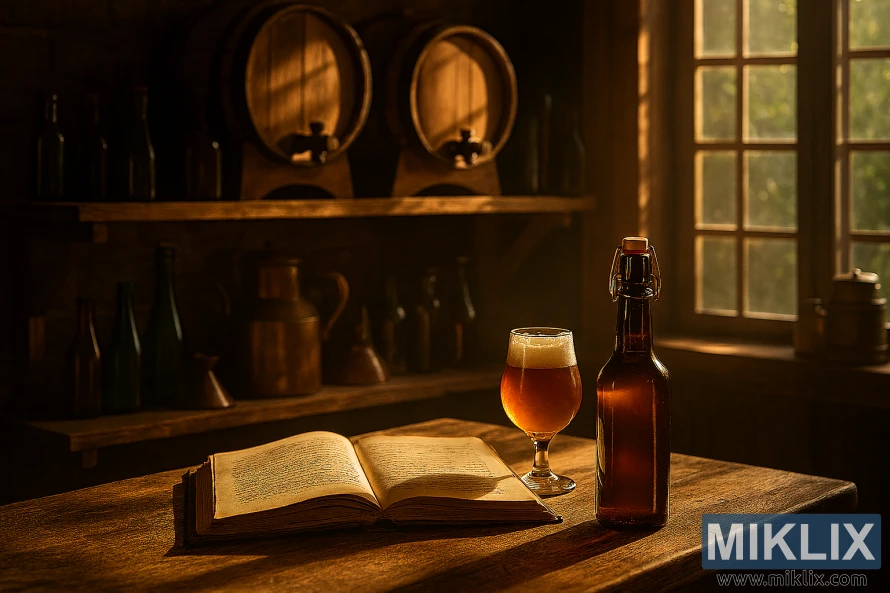
Sample All-Grain Recipe Using Wyeast 2002-PC Gambrinus Style Lager Yeast
Below is a scaled-down template based on an Old World Pils recipe suited for Wyeast 2002 all-grain batches. Use it as a baseline and scale fermentables, water, and hop quantities to your target batch size.
Style: American/Old World Pils. Target OG ~1.034, FG ~1.009, ABV ~3.28%, IBU ~14.7, SRM ~2.5. Carbonation target about 2.65 volumes CO2.
- Fermentables: 100% Pilsner malt (use a high-quality pils such as Weyermann or Pilsner malt from a trusted maltster). Keep the grist light to highlight the Wyeast 2002 all-grain strain’s clean character.
- Hops: Galena pellets, bittering addition boiled 15 minutes to yield ~14.7 IBU. Swap to Saaz or Hallertau for a more traditional Old World Pils profile.
- Water: Soft, low-mineral profile. Adjust to accentuate crisp hopping and malt clarity.
Mash schedule: Strike at 165 °F to reach a target mash temperature of 154 °F. Hold for 60 minutes with a mash thickness near 1.25 qt/lb. Start with grain at about 65 °F. Batch sparge to reach pre-boil volume suitable for your system.
Boil: 60 minutes. Add Galena at 15 minutes remaining. No late aroma hops for a classic clean pils finish.
- Yeast: Wyeast Gambrinus Style Lager (2002-PC). Ferment near 52 °F to showcase subtle malt sweetness and crisp attenuation.
- Starter: Not required for this low gravity example. For larger batches or older packs, prepare a small starter to ensure healthy cell counts.
- Fermentation tip: Hold primary fermentation at 50–54 °F until activity slows, then raise slowly for a short diacetyl rest if needed.
Practical conversion note: Follow mash thickness and water-to-grain guidelines (1.25 qt/lb) and adjust strike and sparge volumes for your equipment. Treat this sample all-grain recipe Gambrinus as a template to test Wyeast 2002’s clean lager profile before experimenting with different hop varieties or higher gravities.
Use this Old World Pils recipe to evaluate pilsner recipe lager yeast performance. Keep records of mash efficiency and fermentation temps to refine future brews.
Pitching Rates, Cell Counts, and When a Starter Is Not Necessary
Ensuring the correct lager pitch rate is crucial for maintaining a clean and steady fermentation process. For lagers, a common guideline is about 0.35 million cells per mL per °P. This figure, combined with your batch volume and gravity, will help you estimate the necessary cell count before chilling the wort or transferring it to a fermenter.
Cell count is more critical for lagers than for many ales. For instance, a 5-gallon low-gravity pilsner with an OG near 1.034 often gets enough viable cells from a fresh Wyeast liquid pack. In such cases, the recipe might indicate "No starter needed," allowing you to pitch directly once the temperatures are right.
For higher gravities and stressed yeast, a higher Wyeast 2002 pitching rate is necessary. Utilize a reliable yeast calculator, such as Brewer’s Friend, Wyeast, or White Labs, to get an exact target. Input OG, volume, and viability to avoid relying on memory.
- When to make a starter: use one if packs are older, harvested yeast has unknown viability, or the beer is above moderate gravity.
- If aiming for fast, vigorous lager fermentation or higher attenuation, build a starter instead of risking underpitch.
Practical steps can help you achieve the recommended cell count for lagers. Consider your goals: flavor clarity, diacetyl clean-up, and fermentation speed. If unsure, create a modest starter to increase cell numbers and shorten the lag phase.
For larger batches, the 0.35 M cells/ml/°P rule applies. Enter your batch specifics into a calculator to avoid underpitching for big-volume or high-OG lagers. A precise approach leads to cleaner lagers and more consistent attenuation.
Fermentation Troubleshooting Specific to This Lager Strain
Slow starts are common with lagers. If activity stalls in the first 48 hours, check pitch rate and oxygenation. A full starter or a second smack pack often wakes sluggish yeast. Track gravity daily to spot a slow ramp early and avoid lager fermentation issues.
Stuck or incomplete attenuation can halt progress late in the run. When gravity levels off near expected terminal readings, raise the temperature to about 60–64 °F for a diacetyl rest. Gently swirl the fermenter to resuspend yeast and encourage cleanup. These steps reduce the chance of stuck fermentation Gambrinus causing off-flavors.
Diacetyl in lager is rarely severe with Wyeast 2002 when managed correctly. Perform a diacetyl rest when gravity hits roughly 1.012. Many homebrewers report that a short warm period removes buttery notes without harming crisp lager character.
Excessive esters show up if the primary runs too warm. Keep primary fermentation at the low end of the recommended range, 46–52 °F, to limit fruity esters. If esters appear, a brief warmer rest can help the yeast reabsorb some compounds.
Flocculation and clarity problems are usually solved by cold conditioning. Wyeast 2002 has medium-high flocculation but benefits from a cold crash and extended lagering. Clear beer takes time; patience at low temperatures improves settling and polish.
- Monitor gravity and compare to expected attenuation (~73%) to judge progress.
- Record temperature at fermenter level; fridge setpoints can differ from beer temperature.
- Oxygenate wort before pitching; lack of oxygen sparks sluggish starts and lager fermentation issues.
When diagnosing stuck fermentation Gambrinus, rule out simple causes first: low cell count, low temperature, or nutrient deficiency. Correct these and give the yeast time to work. If gravity still won’t budge, consider rousing the yeast or adding a fresh, vigorous lager starter.
For diacetyl in lager, prevention wins. Pitch healthy yeast, control temperature, and plan a diacetyl rest near terminal gravity. These actions handle most problems and get the beer back on track without intensive intervention.
Flocculation and Conditioning: Lagering and Clarification
Wyeast 2002 is renowned for its reliable Gambrinus flocculation. It exhibits medium-high flocculation, ensuring most yeast settles effectively after fermentation. Brewers often observe tight yeast beds, resulting in a clear beer.
Following active fermentation, a short diacetyl rest at 60°F for one to three days is recommended. Then, cool the beer to near-freezing to initiate lagering with Wyeast 2002. This cold conditioning phase, lasting multiple weeks, refines malt and hop flavors.
Homebrewers typically lager for two to six weeks. Some recipes may require longer storage. Longer cold storage enhances clarity and refines the flavor without obscuring the beer's base character.
To further polish the beer, employ standard clarifying lager techniques. Cold crashing, fining agents like gelatin or isinglass, and gentle filtration are effective. Ensure sufficient time for settled material to compact before packaging.
Proper lagering with Wyeast 2002 typically results in a clean profile that tastes excellent straight from the fermenter. The conditioning process enhances both clarity and flavor, yielding a bright, refreshing lager.
- Flocculation: medium-high flocculation lager yeast tends to settle reliably.
- Lagering: cold conditioning for weeks to months refines taste and clarity.
- Clarifying lager: cold crash plus finings or filtration improves brightness.
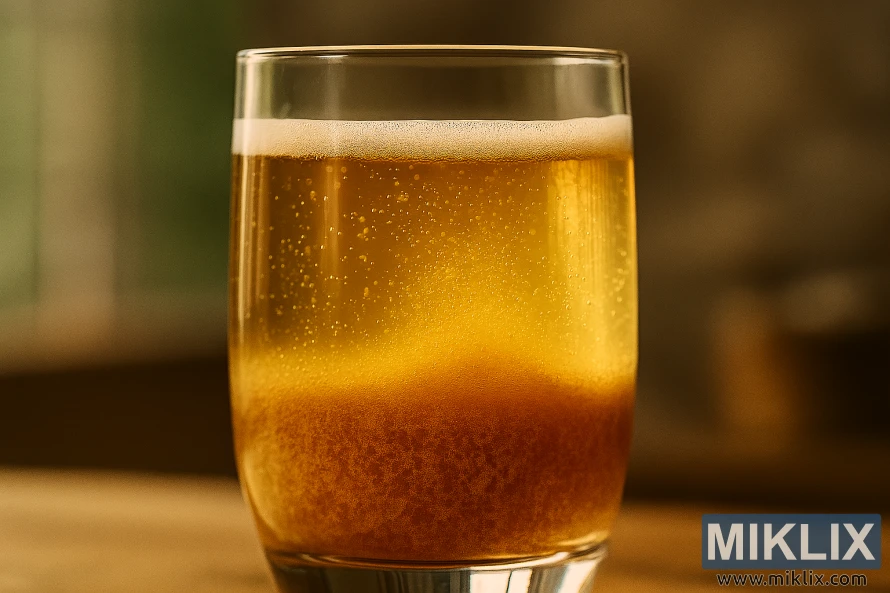
Cell Viability, Re-pitching, and Harvesting Yeast
Liquid yeast's potency wanes with time. Always verify the manufacture and pack dates. Store packs in the fridge. For older vials, prepare a starter to elevate cell count before re-pitching Wyeast 2002 into a lager.
Post-primary fermentation, harvest yeast by scooping the slurry from the fermenter. Carefully decant excess beer, then place the slurry in sanitized jars. Chill them quickly. Sanitizing is crucial to prevent contamination when storing a yeast bank lager for future use.
Lager strains can be reused multiple times, though performance may decline. Assess viability Gambrinus with methylene blue or staining methods. If viability is low, create a stepped starter to boost vigor before re-pitching Wyeast 2002 in another batch.
- Harvesting lager yeast: collect from a clean fermenter, minimize oxygen exposure, and refrigerate at 34–40°F.
- Re-pitch Wyeast 2002: use a starter sized by a yeast calculator when viability is under ideal levels.
- Yeast bank lager: label jars with strain, date, and generation count for trackable reuse.
Account for cell loss with each generation. Utilize a yeast calculator to determine starter volume and generation count for target cell numbers. This tool aids in setting practical starter sizes and schedules for larger lagers.
Handle harvested slurry with utmost care. Work in a clean environment, cap jars loosely during settling, and prevent cross-contamination. When re-pitching, gradually warm the slurry and ensure proper oxygenation during propagation to restore activity.
For long-term storage, consider dividing harvested yeast into small, labeled fractions for a managed yeast bank lager. Rotate through these jars to avoid excessive generations and maintain yeast viability Gambrinus for consistent lager outcomes.
Comparing Wyeast 2002-PC to Other Lager Strains
When evaluating lager yeast strains, several key metrics are crucial. Wyeast 2002-PC, for instance, averages 73% attenuation and flocculates at a medium-high level. This balance ensures clarity without losing malt character.
Wyeast 2002 stands out against other strains mainly due to its temperature tolerance and ester profile. Gambrinus excels at 8–13 °C (46–56 °F), producing clean, subtle esters and soft floral notes. Some German or Czech strains, on the other hand, operate slightly warmer or colder, yielding even cleaner, near-neutral results.
Choosing the right yeast depends on the desired outcome. For ultra-clean lagers, strains marketed as ultra-clean neutral are ideal. Those aiming for higher alcohol or stronger attenuation might opt for strains with higher tolerance and a higher attenuation range than Wyeast 2002.
Flocculation behavior is another critical factor. High-flocculating strains drop out faster, leading to brighter beer sooner. In contrast, low-flocculating options remain suspended during conditioning, influencing haze and mouthfeel.
- Attenuation: Wyeast 2002 ~73%; other strains vary lower or higher.
- Flocculation: medium-high compared to high or low types.
- Temperature tolerance: 8–13 °C typical; other strains may prefer different ranges.
- Flavor: subtle esters with soft floral notes versus ultra-clean or more characterful strains.
For a comprehensive lager yeast comparison, align the strain with the style and desired yeast character. Wyeast 2002 is a versatile choice for continental pilsners and many classic lagers. For a different final profile, explore Gambrinus alternatives that meet your specific attenuation, flocculation, and temperature requirements.
Practical Batch Log: Example Ferment from Homebrewers’ Reports
This Gambrinus batch log details a small-batch pilsner crafted with pale pilsner malt and light hopping. The recipe featured Excelsior Pils malt as the base and Galena hops for a target IBU of 14.7. The goal was to achieve a clean, traditional lager profile, perfect for lager fermentation log comparison.
Pitching happened at around 47 °F with a robust starter. Fermentation, as documented in this Wyeast 2002 homebrew report, progressed smoothly. The brewer observed the yeast to be “politely and quick,” showing consistent activity over the first four days.
The gravity in this fermentation example Gambrinus started at 1.040 and dropped to 1.007. Once the gravity hit about 1.012, the temperature was increased to 60 °F for a diacetyl rest. No diacetyl was found in the sample taken at that time.
The yeast demonstrated strong flocculation and a clean flavor profile. Tasting notes highlighted “malty, cleanish, with a soft, floral note.” The brewer decided to harvest and propagate the yeast for future batches. This decision is echoed in several Wyeast 2002 homebrew report entries.
Operational notes for brewers following this lager fermentation log:
- Monitor gravity and temperature closely from the start.
- Organize a diacetyl rest near terminal gravity, around 1.012 in this case.
- Anticipate confident flocculation and a clean finish, ideal for lagers and pilsners.
Adopt this fermentation example Gambrinus for planning a small-batch pilsner. The Gambrinus batch log offers practical steps and timing for a controlled, repeatable lager ferment.
Conclusion
Wyeast 2002 summary: This Gambrinus style lager strain is a dependable choice for brewers aiming for clean, malt-forward lagers. It offers mild ester complexity. With roughly 73% attenuation, medium-high flocculation, and about 9% ABV tolerance, it reliably produces clear results when pitched correctly and fermented in the 46–56 °F (8–13 °C) range.
Practical notes: For continental pilsners, traditional lagers, and American-style lagers, follow recommended pitching rates. Use a starter for high-gravity or older packs. Perform a diacetyl rest near 60 °F before extended lagering. Many brewers report minimal diacetyl and a soft floral character when the schedule is respected. This strain often balances clean fermentation with pleasant subtlety.
Final assessment: The Gambrinus review conclusion supports Wyeast 2002 as a strong, user-friendly lager option. If you ask should I use Wyeast 2002, the lager yeast verdict is positive for homebrewers seeking consistency and approachable handling. Use yeast calculators and firm temperature control to get the best performance and clarity from this strain.
Further Reading
If you enjoyed this post, you may also like these suggestions:
- Fermenting Beer with Wyeast 1098 British Ale Yeast
- Fermenting Beer with CellarScience Origin Yeast
- Fermenting Beer with CellarScience Kölsch Yeast
